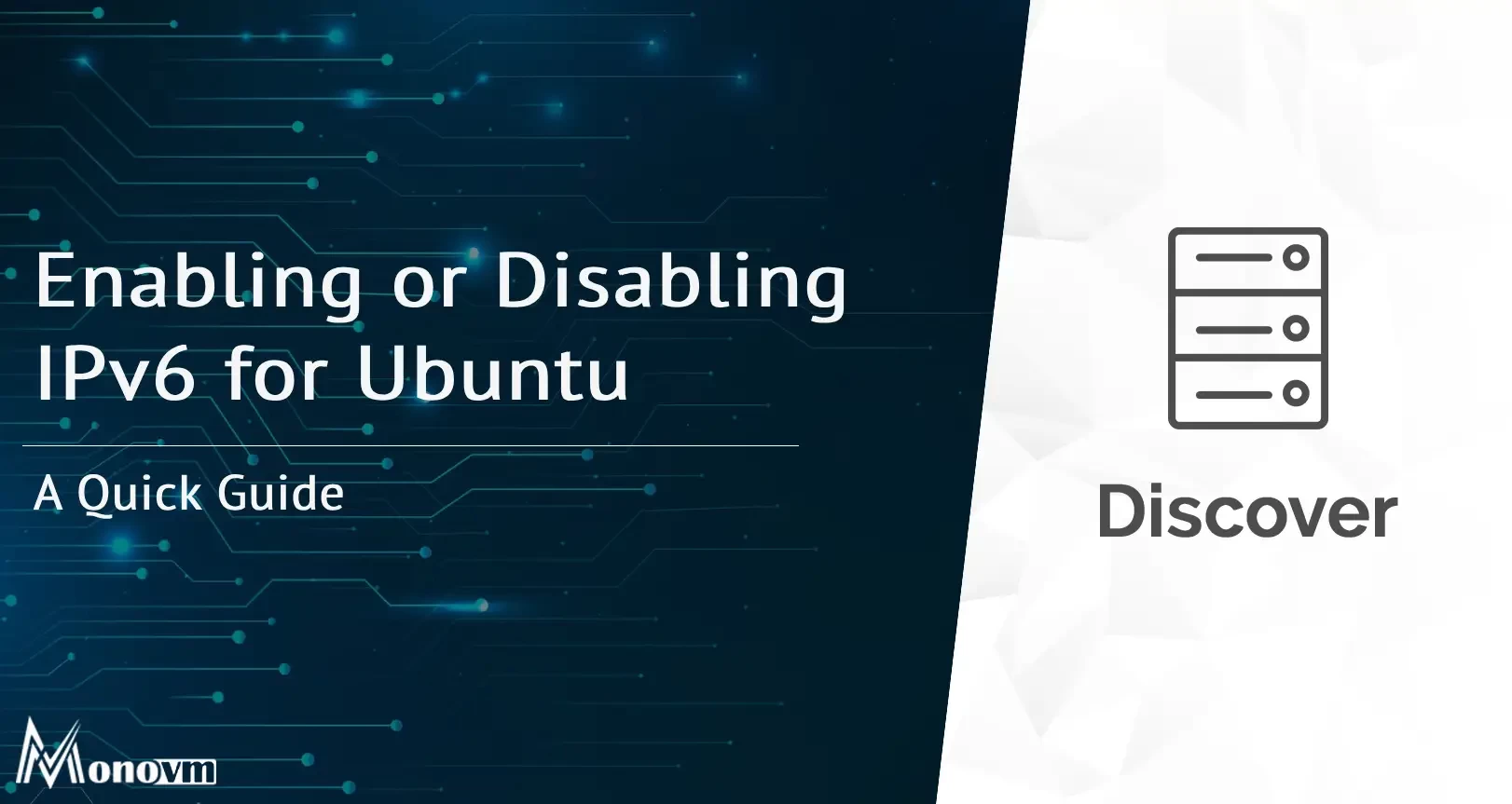List of content you will read in this article:
In today's internet world, IPv6 is the go-to technology to overcome the limitations of IPv4. With more devices needing unique IP addresses, it's essential to know how to control IPv6 on your Ubuntu system. This guide simplifies the process, explaining when and why you might tweak IPv6 settings. Whether you want to ensure future-proofing, solve compatibility issues, or boost performance, this guide is your roadmap. Dive into the details, make choices that fit your network, and step confidently into a well-connected future with your Ubuntu system.
💡 Discover What is IPV6 and why it's crucial for the future of internet connectivity in our detailed guide.
Step-by-Step Guide to Disabling IPv6
To enable or disable IPv6 on Ubuntu, you can use the sysctl command to modify the kernel parameters. Here's how you can do it:
To Disable IPV6
- Open the terminal.
- Edit the sysctl.conf file using a text editor. You can use nano or any other text editor of your choice:
sudo nano /etc/sysctl.conf
🛠️ Enhance your programming toolkit! Discover the simplicity and efficiency of Nano with our How to Use Nano Text Editor guide.
- Add the following lines at the end of the file:
# Disable IPv6
net.ipv6.conf.all.disable_ipv6 = 1
net.ipv6.conf.default.disable_ipv6 = 1
net.ipv6.conf.lo.disable_ipv6 = 1
- Save and close the file.
- Apply the changes by running:
sudo sysctl -p
Note: This will disable IPv6 on your system. Remember that some applications and services might rely on IPv6, so be cautious when disabling it.
To Enable IPv6
To enable IPv6, you can either remove or comment out the lines you added in the sysctl.conf file:
# Disable IPv6
# net.ipv6.conf.all.disable_ipv6 = 1
# net.ipv6.conf.default.disable_ipv6 = 1
# net.ipv6.conf.lo.disable_ipv6 = 1
Then, save and close the file and apply the changes:
sudo sysctl -p
Temporary Disabling/Enabling IPv6
If you want to temporarily disable or enable IPv6 without modifying the sysctl.conf file, you can use the following commands:
To temporarily disable IPv6:
sudo sysctl -w net.ipv6.conf.all.disable_ipv6=1
sudo sysctl -w net.ipv6.conf.default.disable_ipv6=1
sudo sysctl -w net.ipv6.conf.lo.disable_ipv6=1
To temporarily enable IPv6:
sudo sysctl -w net.ipv6.conf.all.disable_ipv6=0
sudo sysctl -w net.ipv6.conf.default.disable_ipv6=0
sudo sysctl -w net.ipv6.conf.lo.disable_ipv6=0
Note: Remember that these changes are not persistent across reboots. If you want to make the changes permanent, modify the sysctl.conf file as mentioned earlier.
Ready to take your Linux skills to the next level? Explore our detailed exploration of Linux Commands for all you need to know.
Temporary Changes IPV6
For users seeking flexibility in managing IPv6 settings without making permanent alterations, Ubuntu provides the option to implement temporary changes. This can be particularly useful for testing compatibility, troubleshooting, or adapting to specific network scenarios. Here's a guide to making temporary changes to IPv6 settings:
Temporary Disablement of IPv6
If you wish to temporarily disable IPv6 on your Ubuntu system, you can use the following commands:
sudo sysctl -w net.ipv6.conf.all.disable_ipv6=1
sudo sysctl -w net.ipv6.conf.default.disable_ipv6=1
sudo sysctl -w net.ipv6.conf.lo.disable_ipv6=1
These commands set the corresponding IPv6 parameters to "1," indicating the temporary disablement of IPv6. Keep in mind that these changes are not persistent across reboots.
Temporary Enablement of IPv6
To temporarily enable IPv6, you can use the following commands:
sudo sysctl -w net.ipv6.conf.all.disable_ipv6=0
sudo sysctl -w net.ipv6.conf.default.disable_ipv6=0
sudo sysctl -w net.ipv6.conf.lo.disable_ipv6=0
These commands set the corresponding IPv6 parameters to "0," indicating the temporary enablement of IPv6. Like the disablement commands, these changes are not permanent.
Note: Temporary changes are useful for assessing the impact of IPv6 on your system or network without committing to long-term modifications. However, for persistent changes, it's recommended to edit the sysctl.conf file as outlined in the relevant sections above. Always exercise caution and thoroughly test any changes, especially in production environments, to avoid unexpected disruptions.
Conclusion
In the dynamic landscape of internet connectivity, understanding how to navigate IPv6 settings on your Ubuntu system is crucial. As we've explored in this comprehensive guide, IPv6 brings forth a new era of possibilities, offering a vast address space, enhanced security features, and improved connectivity. While the internet continues to evolve, the decision to enable or disable IPv6 on your Ubuntu system depends on various factors.
For those facing compatibility issues or troubleshooting network problems, the option to temporarily disable IPv6 provides a valuable testing ground. However, it's essential to recognize that IPv6 is the future of the internet, and disabling it may hinder your system's ability to fully capitalize on emerging technologies.
Conversely, enabling IPv6 aligns with the ever-expanding demands of the digital landscape, ensuring your system remains compatible with the global shift towards IPv6 adoption. The protocol's benefits, including address space scalability and built-in security features, contribute to a more efficient and secure internet experience.
As you navigate the decision to enable or disable IPv6, consider your specific network requirements, application compatibility, and the readiness of your system for the next phase of internet communication. Whether making permanent changes through sysctl.conf or opting for temporary adjustments for testing purposes, always approach these decisions with caution and thorough consideration.
In closing, the world of IPv6 presents a realm of possibilities, and your choice regarding its implementation should be a strategic one, reflecting your system's needs and preparing it for the future of internet connectivity.

Hello, everyone, my name is Lisa. I'm a passionate electrical engineering student with a keen interest in technology. I'm fascinated by the intersection of engineering principles and technological advancements, and I'm eager to contribute to the field by applying my knowledge and skills to solve real-world problems.